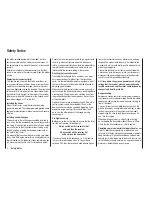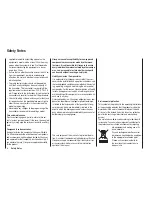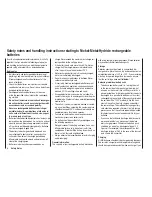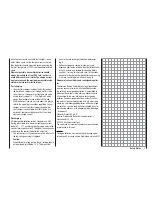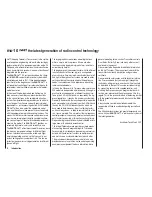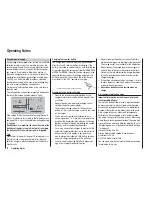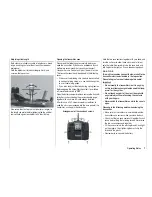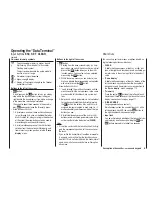
10
Introduction
mx-16
the latest generation of radio control technology
HoTT (Hopping Telemetry Transmission) is the synthe-
sis of expertise, engineering and world-wide testing by
professional pilots. The equipment operates on the 2.4
GHz band, and offers bi-directional communication be-
tween transmitter and receiver via a down-link channel
integrated into the receiver.
The
mx-16
HoTT RC system is based on the
Graup-
ner/JR
mc-24
computer radio control system which
was introduced back in 1997. It has been developed
specifi cally for the beginner, but the
mx-16
HoTT is
still capable of controlling all current model types with-
out problem - whether fi xed-wing model or helicopter,
model boat or car.
In the area of fi xed-wing models and helicopters it is
often necessary to employ complex mixer functions
for the control surfaces or the swashplate actuation
system. Computer technology enables you to activate
a vast range of functions to cope with special model
requirements – just by pressing a button. With the
mx-
16
HoTT all you do is select the appropriate model
type, and the software then presents you automatically
with the appropriate mixer and coupling functions. This
means that the transmitter requires no additional mod-
ules in order to implement complex coupled functions,
and you can forget all about old-fashioned mechanical
mixers in the model. The
mx-16
HoTT provides an
extremely high level of safety and reliability in use.
The
mx-16
HoTT offers twenty model memories, each
of which can store model settings for different fl ight
phases. Individual phases can be called up in fl ight
simply by operating a switch, so that you can try out
various settings quickly and without risk. This can be
for test purposes or for varying parameters for different
phases of fl ight.
The large graphic screen makes operating the trans-
mitter a simple, intuitive process. Mixers and other
functions can be displayed in graphic form, and this is
extraordinarily helpful.
The beginner quickly becomes familiar with the different
functions thanks to the clear, logically arranged pro-
gram structure. Four-way touch-sensitive buttons to left
and right of the high-contrast screen are used to enter
settings, allowing the user to exploit all the options he
needs, in accordance with his experience in handling
radio-controlled models.
In theory the
Graupner
HoTT process allows more than
200 models to be operated simultaneously. Although in
practice the mixed operation of different technical sys-
tems in the 2.4 GHz ISM band – as required by the ap-
proval regulations – reduces this number considerably.
Generally, however, it will always be possible to operate
even more models simultaneously on the 2.4 GHz band
than on the 35 / 40 MHz frequency bands which we
have used to date. However, the actual limiting factor –
as it has always been – is likely to remain the size of the
(air-) space available. The simple fact that no frequency
control procedure is necessary equates to an enormous
gain in safety, especially at fl ying sites such as gliding
slopes where groups of pilots may be distributed over a
large area, with nobody in overall control.
The integral Telemetry menu provides a simple means
of accessing data and programming HoTT receivers.
For example, this method can be used to map receiver
outputs, distribute control functions to multiple servos,
and match servo travels and directions to each other.
This manual describes each menu in detail, and also
provides dozens of useful tips, notes and programming
examples to complement the basic information. More
general modelling terms, such as Transmitter controls,
Dual-Rates, Butterfl y (Crow) and many others, are all
explained in the manual.
Please refer to the Appendix for additional information
on the HoTT system. This manual concludes with the
transmitter’s conformity declaration and guarantee
certifi cate.
Please read the safety notes and the technical informa-
tion. We recommend that you read right through the
instructions with great care, and check all the functions
as described in the text. This can be carried out simply
by connecting servos to the supplied receiver, and
watching their response as you program the transmit-
ter. However, please read the notes on page 20 in this
regard. This is the quickest method of becoming familiar
with the essential procedures and functions of the
mx-
16
HoTT.
Always handle your radio-controlled model with a
responsible attitude to avoid endangering yourself and
others.
The
Graupner
team wishes you great pleasure and suc-
cess with your
mx-16
HoTT - a radio control system of
the latest generation.
Kirchheim-Teck, March 2011
Summary of Contents for mx-16 HOTT
Page 7: ...7 For your notes...
Page 37: ...37 For your notes...
Page 41: ...41 For your notes...
Page 45: ...45 For your notes...
Page 51: ...51 For your notes...
Page 55: ...55 For your notes...
Page 81: ...81 For your notes...
Page 103: ...103 For your notes...
Page 133: ...133 For your notes...
Page 141: ...141 For your notes...
Page 161: ...161 For your notes...
Page 173: ...173 For your notes...




